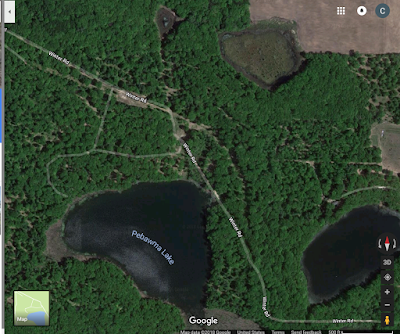The View from the Arrowhead
I remember the first time I sat at the Arrowhead, the stadium seating area dug into a hill overlooking the waterfront. The space was named for its shape, narrowing down to a platform that could serve as a stage for skits and camp-wide announcements. The final point was a sand-filled ledge about five feet below the stage. Another five-foot drop plopped you on the beach by the boathouse.
A staircase sloped down to the right of the seating area, and every day we awkwardly walked it on the way to swimming and boating activities. Even as a young adult, the steps never seemed properly spaced. The builders had shaped them with large logs making each step too long for a single pace but too short for two. I am often surprised there were not more injuries as children dressed in their bathing suits, towels on their shoulders, old sneakers on their feet, plunged down them despite our cries of, “No running!”
The ledges at the bottom of the Arrowhead were also a place for spectacular gravitational feats. As a camper, I remember my counselor, Piker John, giving us a whole activity period to simply jump and climb while he chatted with the ladies of the waterfront staff. Jump! Who went higher? Who went furthest? Climb. Jump!
The Arrowhead was also the place we gathered as a camp at the beginning of a session. After everyone had checked in with health checks and swimming tests, the whole camp sat down on the Arrowhead to learn the regulations of a week or two at Camp Aharah. My first session was in 1979 when I was eight years old. I remember the event because the steps to our log seating were difficult on short legs and, once seated, my feet didn’t quite touch the sand below. We adopted one of two strategies: stand on the sand and lean on the log or let your rear end follow the curve of the log, enhancing the effect of dangling feet.
This portion of the first day was difficult for both campers and staff. We had two sets of rules to cover and a bunch of children who had just spent a few hours on the bus from Kalamazoo to keep still. For the waterfront rules one summer, BooBoo and I had a successful run as ne’er-do-well swimmers, demonstrating the wrong way to behave in the swimming area. The next summer, we were frowned upon and summarily dismissed when Yogi the waterfront director decided brevity was a better plan than comedy.
The second part of the presentation was the camp rules, a list that changed with our insurance policies. In my early summers as a camper, there were few restrictions, and children walked alone to the bathhouse when nature called. By the time I was a counselor, a strict buddy system was in force, and going to the bathroom meant always bringing a pal.
When I was sitting there that first summer as Big Fritz spelled out the lost camper procedures, I took in a landscape that would become my own wonderland. From the Arrowhead, the beach meets the woods, and a trail continues around the lake. It goes by Turtle Cove where we would watch turtles during the day and surprise frogs at night. For a few moments, you can see Winter Drive through the trees, but then the trail curves around the lake, following the hillside.
In a few minutes, you arrive at Ottowa and Iriquois cabins. Between them stands an old red metal trough with a squeaky handpump. It seemed every group that passed by felt compelled to work it until rewarded with a cold stream. The older adventure camping groups used it frequently for handwashing and toothbrushing in the mornings and evenings. I remember how blessed we felt the summer they decided to put an outhouse near the cabins, saving us a 10-minute walk to the bathhouse.
Past the cabins, the trail slopes down to East Beach, the former public lake access. This sandy area was supposed to be reserved for people from the Walkerville area who wanted to fish on the lake. However, it was also a well-known party spot in the off-season. More than once, staff members had to charge down the trail to disrupt unauthorized gatherings, doing our best at 19 and 20 to look imposing to high-school-aged farm kids who were certainly stronger than most of us.
Following the trail past the beach, you enter swamp walk territory. When I was a CIT, one of our summer projects was building a bridge out of unused wooden docks that crossed the swampy inlet. When first installed, you could walk mud-free around the lake. Then, the lake rose and the swamp expanded. Five years later, the bridge was submerged, and reaching it involved a walk through the muck on either side.
The trail continues and approaches Huron Hill, a popular spot for overnight camping. A small dock down by the lake let cabin groups ferry their equipment over by canoe. There are several traditions about the hill being a place for tribal councils and burial grounds in previous centuries. I remember campfires in the dark woods, listening to the sounds of friends echoing across the lake mixed with owl hoots and frog croaks.
Sitting on the Arrowhead, oak and pine trees block the view of the rest of the lake. Carl, the eight-year-old camper, knows none of this geography. The wind plays on the water and the reflections of the afternoon sun sparkle. He looks out over the lake and asks the eternal, burning question. “What comes next?”


Comments
Post a Comment